It looks like you're using an Ad Blocker.
Please white-list or disable AboveTopSecret.com in your ad-blocking tool.
Thank you.
Some features of ATS will be disabled while you continue to use an ad-blocker.
share:
originally posted by: micpsi
AND THAT DOES POSE A PROBLEM FOR THEM BECAUSE THEY JOLLY WELL KNOW THAT ONLY IRON TOOLS - NOT COPPER OR BRONZE TOOLS - CAN CUT GRANITE AND ANDESITE, ETC. ONLY THEY WILL NEVER ADMIT IT PUBLICLY BECAUSE IT IMPLIES A LEVEL OF TECHNOLOGY WAS USED IN SOUTH AMERICA THAT WAS MUCH HIGHER THAN WHAT THEIR HISTORICAL PARADIGM CAN ADMIT.
Pre-Bronze Age diorite jar:
Link
The Stela of Hammurabi is Bronze Age diorite carving.
Link
Diorite is harder to "cut" than granite or andesite.
So, it seems that it's only YOU that "KNOW(s) THAT ONLY IRON TOOLS - NOT COPPER OR BRONZE TOOLS - CAN CUT GRANITE AND ANDESITE, ETC."
See, scientists have known for quite some time now that granite, diorite, granite and other hard stones were carved in the ancient past - and even have evidence of the processes used.
Might be better to know a little something about a subject before you go all caps and scream it to everyone.
Harte
I always love it when this comes around I get to show my favorite picture of Gudea
originally posted by: Harte
The Stela of Hammurabi is Bronze Age diorite carving.
Link
Diorite is harder to "cut" than granite or andesite.
So, it seems that it's only YOU that "KNOW(s) THAT ONLY IRON TOOLS - NOT COPPER OR BRONZE TOOLS - CAN CUT GRANITE AND ANDESITE, ETC."
See, scientists have known for quite some time now that granite, diorite, granite and other hard stones were carved in the ancient past - and even have evidence of the processes used.
Might be better to know a little something about a subject before you go all caps and scream it to everyone.
Harte
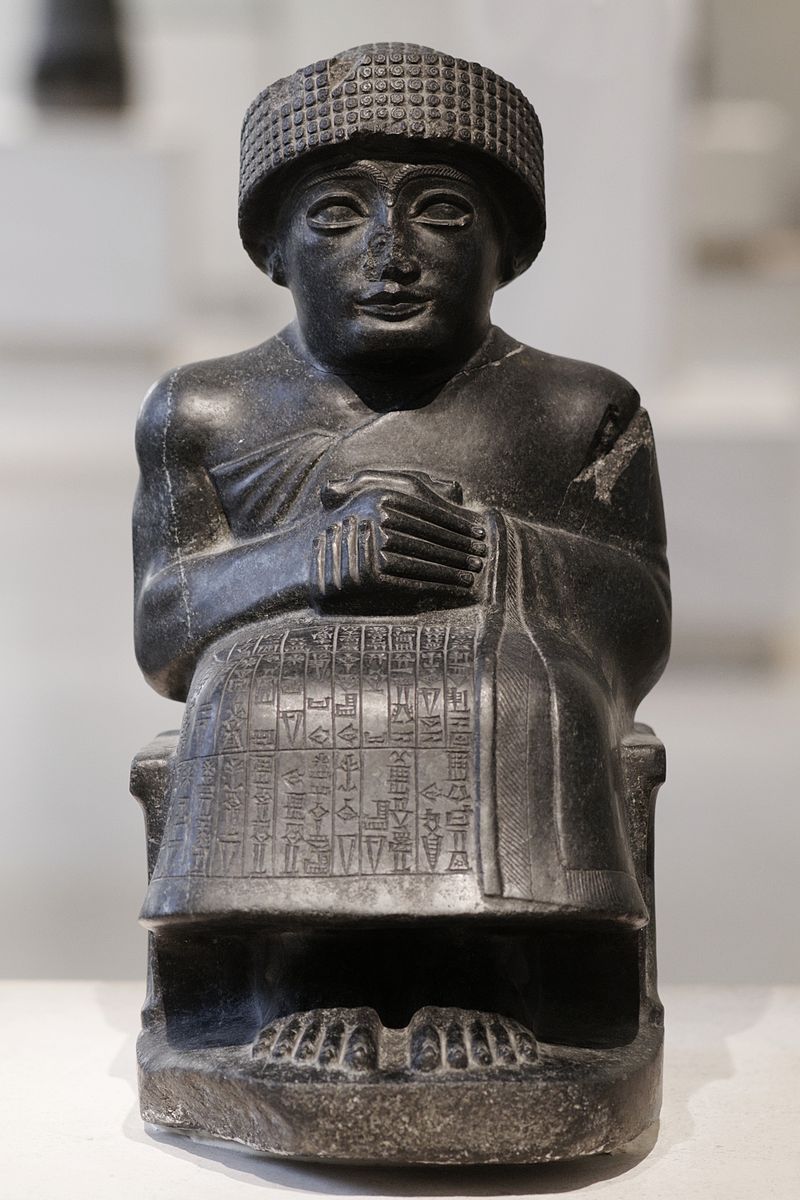
www.louvre.fr...
Harte how often does this same mistake show up? 2 times a month we're breathless told that an evil conspiracy is hiding the fact that ancient couldn't work hard stone................................
www.hallofmaat.com...
originally posted by: new_here
a reply to: LedermanStudio
Cool discovery.
But, am I the only one who wonders why they are so sure these kinds of finds are necessarily temples? It could be a marketplace or a town hangout. Why is it always a place of worship?
Because, in their apparent ignorance, it couldn't be anything else, as our ancestors were just a superstitious lot with nothing more to do than build temples to unseen beings. Design implies purpose, design needs planning and intent, design requires discussion and agreement...design needs visual and tangible plans...and a coherent strategy to fulfil the vision. Design requires intelligence and societal environment.
originally posted by: Hanslune
I always love it when this comes around I get to show my favorite picture of Gudea.
I've always liked that pose with hands clasped together in front. It seems so much like, "Well, I'm listening. Tell me more." Although you can kind of see where it might have evolved from an earlier depiction of a man with two hands in front holding up his wiener.
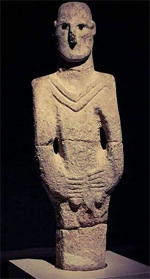
So, it seems that it's only YOU that "KNOW(s) THAT ONLY IRON TOOLS - NOT COPPER OR BRONZE TOOLS - CAN CUT GRANITE AND ANDESITE, ETC." See,
scientists have known for quite some time now that granite, diorite, granite and other hard stones were carved in the ancient past - and even have
evidence of the processes used. Might be better to know a little something about a subject before you go all caps and scream it to everyone. a
reply to: Harte
I’m not trying to derail this thread , merely adding a reply :
Those who follow the ‘stone cutting’ debates on here should not be bowled over by Harte’s apparently authoritative replies regarding this issue.
As a machinist and someone who works in tooling every day I see it differently . This answer applies to Hanslune’s scoffing replies to those who ask questions.
Yeah, sure , the ancients could work hard stone. They could carve it like Hanslunes apparent ‘ace’ up his sleeve, took a long time I should imagine, but of course, it’s a fine work by a fine craftsman.
But when you talk of large tonne-plus stones showing a level of accuracy that’s above hand carving capabilities, coupled with striations from the tools left behind that forensically match circular cutting blades/saws things change I’m afraid .
I’ve said this before, but none of those ‘edges’ we see on these stones were ‘carved’. They are RESULTANT edges left by a large blade passing through the material at one angle , then cut again at a right angle . This LEAVES BEHIND a sharp edge. The edge is NOT created as a separate entity , it OCCURS after two cuts.
Hanslune and Harte make me laugh with their total assertions that these blocks were not cut in this way.
They are just as bad as the well -meaning people on here that they scoff at with their belief that all this work was ‘carved’. To anyone with a machinists eye, they weren’t .
Believe me, Harte knows no more than you or I, as none of us were there when these were made.
As for the copper tooling, I’m afraid these have been mistaken by those in academia- they are carpentry tools in my opinion. They would cut wood beautifully , but certainly have a terrible time trying to cut a straight edge on a lump of granite with it.
Isn’t it funny that guys like Harte and Hanslune want the ‘fringers’ to accept their ridiculous propositions about carving when the forensic evidence on the stone and indeed the resultant edges on the stone speak otherwise.
If anyone’s interested, look up how resultant edges are formed in machining or modern stone mills. Once you see it done, you’ll never look at these blocks of stone quite the same way again.
I’m not trying to derail this thread , merely adding a reply :
Those who follow the ‘stone cutting’ debates on here should not be bowled over by Harte’s apparently authoritative replies regarding this issue.
As a machinist and someone who works in tooling every day I see it differently . This answer applies to Hanslune’s scoffing replies to those who ask questions.
Yeah, sure , the ancients could work hard stone. They could carve it like Hanslunes apparent ‘ace’ up his sleeve, took a long time I should imagine, but of course, it’s a fine work by a fine craftsman.
But when you talk of large tonne-plus stones showing a level of accuracy that’s above hand carving capabilities, coupled with striations from the tools left behind that forensically match circular cutting blades/saws things change I’m afraid .
I’ve said this before, but none of those ‘edges’ we see on these stones were ‘carved’. They are RESULTANT edges left by a large blade passing through the material at one angle , then cut again at a right angle . This LEAVES BEHIND a sharp edge. The edge is NOT created as a separate entity , it OCCURS after two cuts.
Hanslune and Harte make me laugh with their total assertions that these blocks were not cut in this way.
They are just as bad as the well -meaning people on here that they scoff at with their belief that all this work was ‘carved’. To anyone with a machinists eye, they weren’t .
Believe me, Harte knows no more than you or I, as none of us were there when these were made.
As for the copper tooling, I’m afraid these have been mistaken by those in academia- they are carpentry tools in my opinion. They would cut wood beautifully , but certainly have a terrible time trying to cut a straight edge on a lump of granite with it.
Isn’t it funny that guys like Harte and Hanslune want the ‘fringers’ to accept their ridiculous propositions about carving when the forensic evidence on the stone and indeed the resultant edges on the stone speak otherwise.
If anyone’s interested, look up how resultant edges are formed in machining or modern stone mills. Once you see it done, you’ll never look at these blocks of stone quite the same way again.
Well, "Harte knows" that the magical "striations" you mention have been made in modern times by hand- powered copper tube saws and slabbing saws.
You, on the other hand, prefer to turn a blind eye to this verifiable fact.
I believe I've stated hundreds of times here why you (and others) do that.
Harte also knows that the term "carved" does not apply to finely surfaced stones from AE. So claiming a "level of accuracy that’s above hand carving capabilities" is a straw man. Those surfaces were pecked and ground, another entirely viable stone cutting method that, once again, you prefer to turn a blind eye to - and for the same reason.
Harte
You, on the other hand, prefer to turn a blind eye to this verifiable fact.
I believe I've stated hundreds of times here why you (and others) do that.
Harte also knows that the term "carved" does not apply to finely surfaced stones from AE. So claiming a "level of accuracy that’s above hand carving capabilities" is a straw man. Those surfaces were pecked and ground, another entirely viable stone cutting method that, once again, you prefer to turn a blind eye to - and for the same reason.
Harte
a reply to: Harte
Well, "Harte knows" that the magical "striations" you mention have been made in modern times by hand- powered copper tube saws and slabbing saws. You, on the other hand, prefer to turn a blind eye to this verifiable fact. I believe I've stated hundreds of times here why you (and others) do that. Harte also knows that the term "carved" does not apply to finely surfaced stones from AE. So claiming a "level of accuracy that’s above hand carving capabilities" is a straw man. Those surfaces were pecked and ground, another entirely viable stone cutting method that, once again, you prefer to turn a blind eye to - and for the same reason.
And this from a guy who on a previous thread told us he worked on lathes, like myself, and yet couldn’t recognise pure lathe turned circular striations on an Egyptian bowl/plate. Laughable.
In AE case, we are talking about a culture that thought BIG. Do you think this wouldn’t apply to their tooling methods?
Stocks’ ‘proof of concept’ that you always bang on about doesn’t hold tight when you examine it further. You can’t cut a straight line without rigidity.no answer from stocks there , as he didn’t replicate a full ‘squared’ granite box, for example.
Stocks never showed how to do internal cambers at 90 degrees , with a saw or pounding stone . Because you can’t .
Stocks’ core drill attempt doesn’t marry with the cast made by C Dunn of the Petrie core. From his casting it looks like indeed the tool did descend in one complete spiral. This implies rigidity. Nothing like Stocks’ scratchy back and forth hacking.
Slow chopping /pounding away at an ‘edge’ is too random for what we see in some AE work and indeed in S America .
This doesn’t mean the AE had modern versions of what machinery I’m talking about and electricity etc, the CONCEPTS of passing a cutter along a surface, the concept of the workpiece spinning and a tool applied is not beyond them . Lathes can be vertical or horizontal. Milling type cuts where the stone is passed under a cutter Is not beyond them.
Using their technology, it would be possible to cast a large disk attached to a hand crank and feed stone against it. Or set up a hand cranked turntable to rotate a piece for circular cutting. It’s not beyond them.
They knew about rotational cutting , and wouldn’t have applied it elsewhere?
Re statues and sculptures : we have always had artistic sculptors who work in stone. They produce beautiful work that takes a long time and reflects this. The same today could be said in metalwork sculpting. These people , however talented etc , are not the people who make parts for heavy industry.
A metal sculptor probably could not make a tolerance-based piece for a car, or building, or aeroplane.
This applies to AE stonework- artistic objects of beauty vs functional fabrication pieces . Two different experts did them. Different approach to time, maths and function.
Mass producing stone to build a great pyramid in say, 25 yrs needs a different approach to the stone, and that’s what we see here.
The large granite pieces we see are cut differently, sharper edged than limestone pieces because granite is harder and they seemingly had the means to achieve a rigid efficient set-up to cut it.
originally posted by: bluesfreak
Mass producing stone to build a great pyramid in say, 25 yrs needs a different approach to the stone, and that’s what we see here.
The large granite pieces we see are cut differently, sharper edged than limestone pieces because granite is harder and they seemingly had the means to achieve a rigid efficient set-up to cut it.
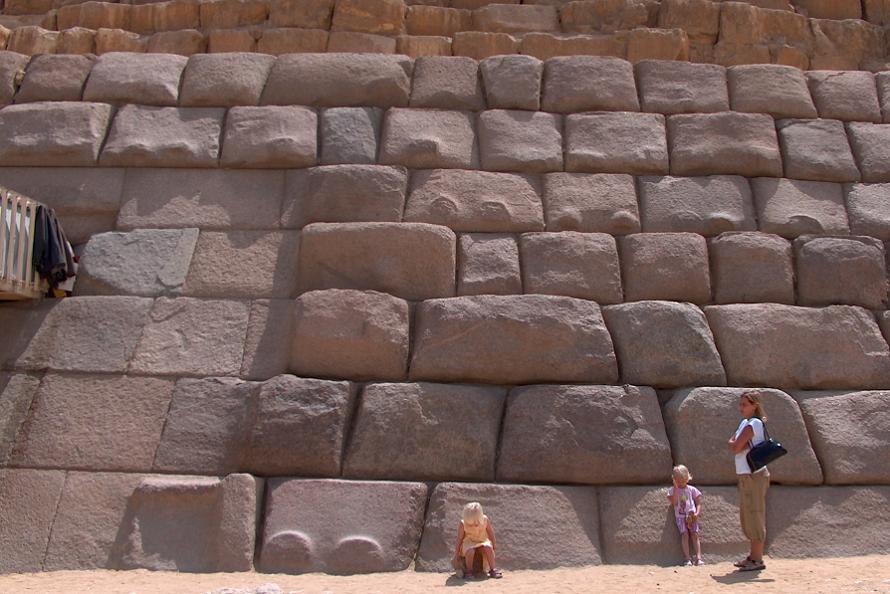
Okay here is an image of 'mass produced granite for Menkaure's pyramid - explain to us how this shows 'mass production''? To me it looks like individual blocks put in place then finished and that stopped probably when Menkaure died leaving us an uncompleted pyramid whose lower out courses are made of finished and unfinished granite. Note the state of the finished granite (looks good) unfinished - well yuck, probably produced by different teams with definitely different ideas on how to do it.
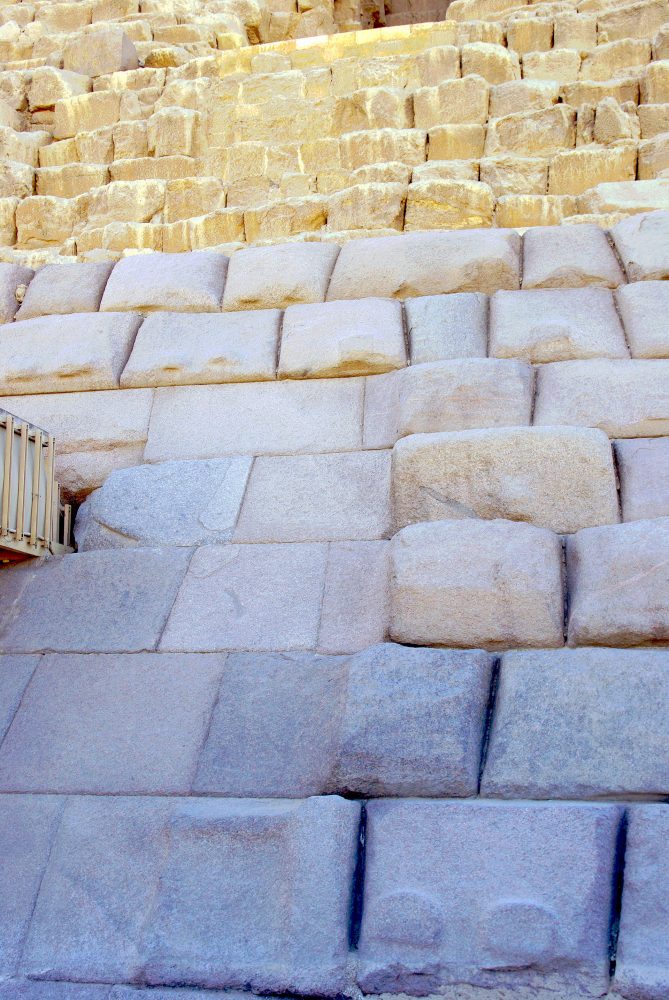
Now could they have used some unknown method of simple mass production? Sure, the problem is we have no evidence of it.
The evidence of that might be found at their quarries but as far I know those who have studied them have found nothing to indicate this.
www.eeescience.utoledo.edu...
a reply to: Hanslune
Okay here is an image of 'mass produced granite for Menkaure's pyramid - explain to us how this shows 'mass production''? To me it looks like individual blocks put in place then finished and that stopped probably when Menkaure died leaving us an uncompleted pyramid whose lower out courses are made of finished and unfinished granite. Note the state of the finished granite (looks good) unfinished - well yuck, probably produced by different teams with definitely different ideas on how to do it.
I note that most of the points I raised are not addressed, however I will respond to yours .
It’s obvious that techniques in masonry and all fabrication change over time. Here are some examples of casing stones from other pyramids fabricated in a different way to Menkaure’s . The resultant edging from a tool passed at two different angles are obvious to me.
Two pictures of the same base casing of the Great Pyramid proving the piece is both undisturbed and not a modern replica . The next are casing stones from the Bent Pyramid . The Bent Pyramid casing looks pretty mass produced and repeatable to me.
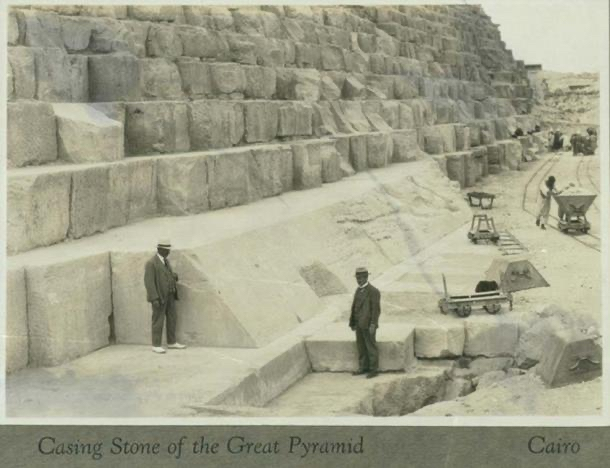
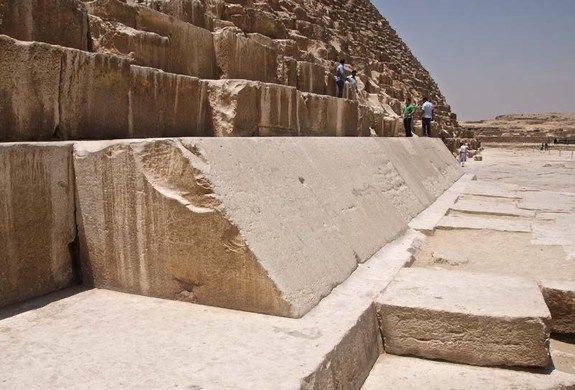
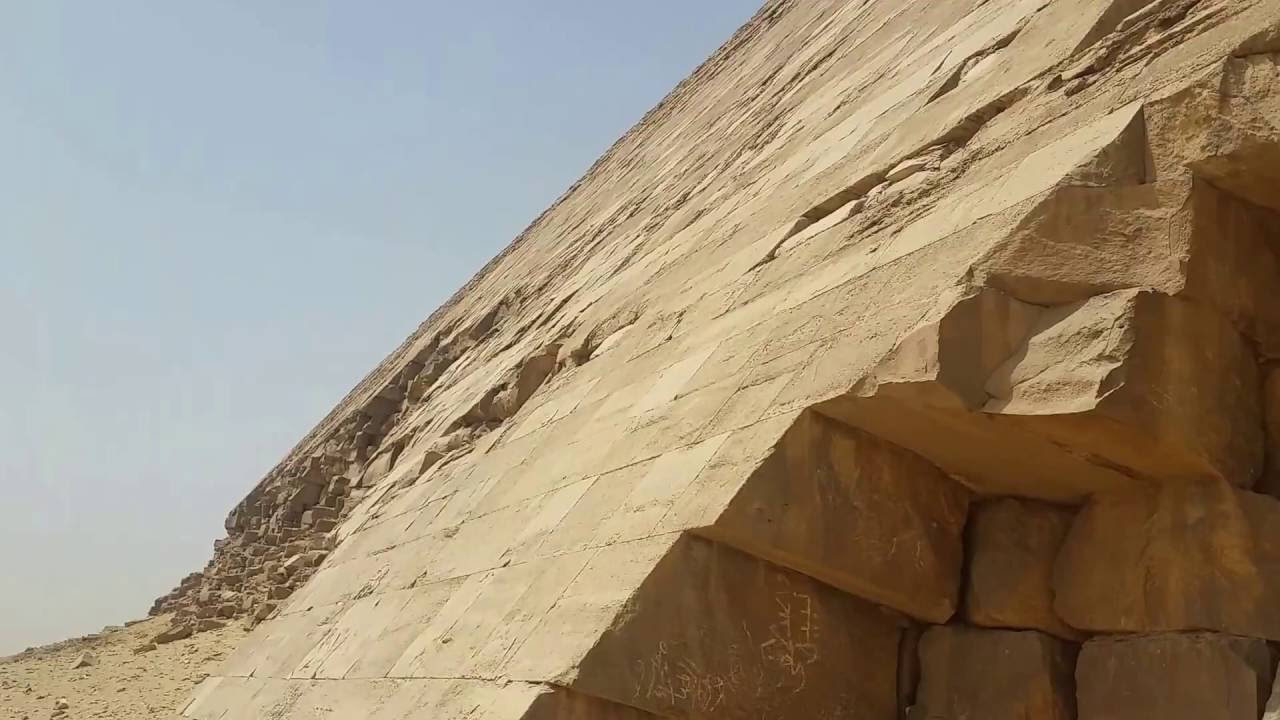
Maybe you might want to address the points I raised ?
edit on 26-11-2019 by bluesfreak because: (no reason given)
originally posted by: bluesfreak
a reply to: Harte
Well, "Harte knows" that the magical "striations" you mention have been made in modern times by hand- powered copper tube saws and slabbing saws. You, on the other hand, prefer to turn a blind eye to this verifiable fact. I believe I've stated hundreds of times here why you (and others) do that. Harte also knows that the term "carved" does not apply to finely surfaced stones from AE. So claiming a "level of accuracy that’s above hand carving capabilities" is a straw man. Those surfaces were pecked and ground, another entirely viable stone cutting method that, once again, you prefer to turn a blind eye to - and for the same reason.
And this from a guy who on a previous thread told us he worked on lathes, like myself, and yet couldn’t recognise pure lathe turned circular striations on an Egyptian bowl/plate. Laughable.
What's "laughable" is that I have reported on upright lathes that were used to turn those bowls (the work remained stationary while the tool was turned) but you refuse to acknowledge that fact as well.
Keep going and you'll be all the way out of reality.
Harte
You stated categorically that they did not have lathes. You are referring to your post where you were talking about hollowed out vases. You stated
that a core drill was turned vertically into the centre of a block to start the process. That is not Lathe turning. On a Lathe, if you remember from
when you claim you used them , the WORKPIECE turns and a tool is applied. Drilling is drilling.
You decried lathes in AE, now you are saying you put it forward ?
Handily, you’ve distracted the conversation so that you don’t have to respond most of the points I raised. Maybe you might like to try responding , too? reply to: Harte
You decried lathes in AE, now you are saying you put it forward ?
Handily, you’ve distracted the conversation so that you don’t have to respond most of the points I raised. Maybe you might like to try responding , too? reply to: Harte
a reply to: Harte
What's "laughable" is that I have reported on upright lathes that were used to turn those bowls (the work remained stationary while the tool was turned) but you refuse to acknowledge that fact as well. Keep going and you'll be all the way out of reality.
No , what’s more laughable is what you actually said , here it is, in case you’ve forgotten. I hadn’t .

Perhaps you might address my valid points now instead of your usual M.O of moving the conversation along when inconvenient by asking more questions.
I think in my last two long posts I posed enough points and questions for you to be getting on with ..
edit on 26-11-2019 by bluesfreak because: (no reason given)
originally posted by: bluesfreak
a reply to: Hanslune
Okay here is an image of 'mass produced granite for Menkaure's pyramid - explain to us how this shows 'mass production''? To me it looks like individual blocks put in place then finished and that stopped probably when Menkaure died leaving us an uncompleted pyramid whose lower out courses are made of finished and unfinished granite. Note the state of the finished granite (looks good) unfinished - well yuck, probably produced by different teams with definitely different ideas on how to do it.
Sorry you are trying to avoid the discussion about granite that YOU started. Please explain what the Menkaure's cladding of granite - both finished and unfinished says about the falsity of your ideas?
I deleted your other points to cover AFTER we finish up about granite.
I presume also that you found it impossible to look at the quarry information I mean who needs information about the subject at hand? LOL
edit on 26/11/19 by Hanslune because: (no reason given)
Well actually I didn’t start the debate on granite, I merely responded to Harte’s reply to micpsi .
Im not sure what info you want me to provide about the quarry at Aswan.
Perhaps you want me to talk about the tooling marks underneath the unfinished obelisk?
Tooling marks unlike any other seen on AE stonework? ‘Scoops’ of granite removed at a clearly fast rate, and done in scoops of the same width.
Oh, and those strange ‘D’ shaped “Test pits” that couldn’t have been pounded out by stone balls down to five feet in depth. Ever thought that they could have held large posts for creating a rigid jig of some type to cut the obelisk ?You probably wouldn’t/couldn’t consider that .
The Menkaure casing is plainly a different design to the bent pyramid. I just happened to show you a different set of casing stones done in a different way that looks highly repeatable to me.
If a cutting tool was angled at , let’s say, 51.5 degrees, and a squared block (rectangular by the look of it at the Bent Pyramid) was passed through it, or it along the block, you will repeat the desired casing angle for every block you cut. That’s what it looks like at the great pyramid and the bent pyramid .
The Menkaure technique does appear to be as you described, stone laid in and the surface brought to alignment. It’s a different technique with rhomboidal blocks mixed in with regular blocks then faced after.
Looking along the base of the casing stones of the Bent Pyramid it is plain to see that the blocks were cut to a higher specification first then fitted together. Wonder why the earlier casing stones on the Bent Pyramid look cleaner and sharper than those of Menkaure?
a reply to: Hanslune
Im not sure what info you want me to provide about the quarry at Aswan.
Perhaps you want me to talk about the tooling marks underneath the unfinished obelisk?
Tooling marks unlike any other seen on AE stonework? ‘Scoops’ of granite removed at a clearly fast rate, and done in scoops of the same width.
Oh, and those strange ‘D’ shaped “Test pits” that couldn’t have been pounded out by stone balls down to five feet in depth. Ever thought that they could have held large posts for creating a rigid jig of some type to cut the obelisk ?You probably wouldn’t/couldn’t consider that .
The Menkaure casing is plainly a different design to the bent pyramid. I just happened to show you a different set of casing stones done in a different way that looks highly repeatable to me.
If a cutting tool was angled at , let’s say, 51.5 degrees, and a squared block (rectangular by the look of it at the Bent Pyramid) was passed through it, or it along the block, you will repeat the desired casing angle for every block you cut. That’s what it looks like at the great pyramid and the bent pyramid .
The Menkaure technique does appear to be as you described, stone laid in and the surface brought to alignment. It’s a different technique with rhomboidal blocks mixed in with regular blocks then faced after.
Looking along the base of the casing stones of the Bent Pyramid it is plain to see that the blocks were cut to a higher specification first then fitted together. Wonder why the earlier casing stones on the Bent Pyramid look cleaner and sharper than those of Menkaure?
a reply to: Hanslune
originally posted by: bluesfreak
a reply to: Harte
What's "laughable" is that I have reported on upright lathes that were used to turn those bowls (the work remained stationary while the tool was turned) but you refuse to acknowledge that fact as well. Keep going and you'll be all the way out of reality.
No , what’s more laughable is what you actually said , here it is, in case you’ve forgotten. I hadn’t .
Perhaps you might address my valid points now instead of your usual M.O of moving the conversation along when inconvenient by asking more questions.
I think in my last two long posts I posed enough points and questions for you to be getting on with ..
Once more you ignore anything posted that tends to disagree with your outrageous claims.
originally posted by: Harte
originally posted by: bluesfreak
These marks that are claimed to be left by facing on a lathe are basically the same as marks left by abrading with a rotating tool, instead of a rotating piece. The AEs were perfectly capable of abrading the troughs into the artifact in question using a succession of tube saws of different diameters. The necessary requirement that seems to me to be the most difficult is to ensure that each saw centers on the same spot.
The marks are not ‘basically’ the same at all, you are simply repeating nonsense.
Lathe striations are far more ‘pure’ and will never resemble core drills. Ever.
Perhaps I’ll treat you as you regularly treat people on this forum who know less about a subject than you:
It’s not my fault you cannot comprehend the evidence laid out before you .
reply to: Harte
Not so "pure" when working in stone.
You realize that the cores found were at first attributed to lathes, right?
Yet we know now they were done with tube saws.
Maybe if you had a better picture your claim would hold a little water. Otherwise, there's nothing in that pic that a saw can't do. The center could be made with the same kind of grinder they used for the interiors of vessels, attached to an extension and bow and spun to wear the center down into the "cup" shape it exhibits. The circular walls could certainly have been made with saws, with the center left in place for grinding.
Again, the only difficult part I see is ensuring the series of saws were centered on the same point.
Now, rather than pretend to some knowledge you claim I (and others) don't have, why don't you explain exactly how the marks differ from similar marks on other stones that were sawn? Until you can do that, you've not "laid out" any "evidence" at all except for your own personal penchant for seeing lathe marks on everything.
Harte
What I said
Now, we could possibly agree that a rotating tool and a stationary workpiece isn't a lathe in the strictest sense.
However, seeing as how a stone vessel has been made this way by Denys Stocks (and a couple of Russians to boot,) I think your claims of stone working lathes (as in machines that turn the workpiece against a stationary tool) in Ancient Egypt is flatly wrong, misguided and the subject of your own peculiar obsessions. You state made-up opinion as if it were fact while simultaneously ignoring perfectly plausible (and actually demonstrated) methodology that would easily explain the manufacture of stone vessels in predynastic Egypt.
As I stated previously, I have gone deeply into why you (and others) act this way in hundreds of previous posts. If you wish, i could expound on that aspect of your flawed personality once again.
Harte
originally posted by: bluesfreak
The Menkaure casing is plainly a different design to the bent pyramid. I just happened to show you a different set of casing stones done in a different way that looks highly repeatable to me.
You appear to just be talking nonsense. I made no mention of the Bent pyramid. I asked you about how the Menkaure granite cladding fitted in with your ideas - you later showed limestone cladding stone from the GP for some odd reason.
The Menkaure technique does appear to be as you described, stone laid in and the surface brought to alignment. It’s a different technique with rhomboidal blocks mixed in with regular blocks then faced after.
So it doesn't look like some massively well organized action at the quarry's was occurring they cut out roughly granite blocks and sent them to be set then finished on site.
Wonder why the earlier casing stones on the Bent Pyramid look cleaner and sharper than those of Menkaure?
Limestone is easier to shape than granite despite what you earlier said:
To wit:
Mass producing stone to build a great pyramid in say, 25 yrs needs a different approach to the stone, and that’s what we see here. The large granite pieces we see are cut differently, sharper edged than limestone pieces because granite is harder and they seemingly had the means to achieve a rigid efficient set-up to cut it.
Yeah they roughly cut it, set it, and then finished it and probably used a high tech wooden stick to make sure it was level.
originally posted by: Harte
As I stated previously, I have gone deeply into why you (and others) act this way in hundreds of previous posts. If you wish, i could expound on that aspect of your flawed personality once again.
Harte
Hundreds and hundreds of times - the same old same old.......: ]
a reply to: Harte
As I stated previously, I have gone deeply into why you (and others) act this way in hundreds of previous posts. If you wish, i could expound on that aspect of your flawed personality once again.
Pretty funny. The thing is, when we were talking about lathes regarding bowl turning, there is a specific reason why a lathe fits in with the execution of some of them.
If I have to explain to you again for the ‘nth time, as you don’t seem to understand , even though you claim to have used one:
A turning workpiece produces circular striations related to the centre of the piece. It also allows the easy cutting of CURVES inside ( like a bowl ) . Not achievable with a vertical drill. How many times do I have to explain to you how a lathe works when you claim to have used them???!!!!
For the record , the bowls with handles aren’t turned on a lathe as it would smash the handles off, so don’t lump me in there .
Internal work, curved work, work with circular striations related to a centre point is what I’m talking about. Like the strange ringed ‘plate’ I replicated for you .
You appear to disregard tooling forensics, that’s your personality disorder. It’s because you don’t know what they are though, so maybe not your fault .
edit on 27-11-2019 by bluesfreak because: (no reason given)
edit on 27-11-2019 by bluesfreak because: (no reason
given)
a reply to: Hanslune
You appear to just be talking nonsense. I made no mention of the Bent pyramid. I asked you about how the Menkaure granite cladding fitted in with your ideas - you later showed limestone cladding stone from the GP for some odd reason.
I was talking about different methods of cutting stone , so not sure why it’s nonsense . One could argue that material doesn’t matter , as the AE could cut granite as easily as limestone it appears, but that’s a different argument.
I was showing a method of replication that the AE achieved that is a different method, that’s all. Both the Great Pyramid and Bent Pyramid appear to have the same method of cladding execution.
So it doesn't look like some massively well organized action at the quarry's was occurring they cut out roughly granite blocks and sent them to be set then finished on site.
Are you kidding ?? Building a pyramid, let alone cladding it doesn’t require huge organised effort?
The Menkaure cladding is indeed a different method, I don’t dispute it, in fact I embrace it . Engineers and machinists are forever trying different techniques to achieve the same goal . It’s what we do .
There are many granite artifacts that show different production techniques to the artistic statues. The statues are polished for aesthetic perfection; functional engineering pieces don’t need to be, that’s why we find tooling striations on them . Two different experts made them.
Granite will always look ‘sharper’ than limestone when cut as its harder. I never stated otherwise. However, those casing stones on the Bent Pyramid look very ‘sharp’ to me compared with the Menkaure technique. That’s why they were made in a repeatable fashion as is obvious by just looking at them with your eyes.
eah they roughly cut it, set it, and then finished it and probably used a high tech wooden stick to make sure it was level.
Yeah that’s right, a wooden stick . After calculating the wieght of the structure they were building, calculating an idea of how many blocks were needed, organising quarrying, stone transport, stone workers, mathematics of retaining and maintaining a steady and accurate angle to clad the structure so it doesn’t look ‘out’ , they used a stick to finish it off. What a joke.
I’ve always wondered what the ‘knobs’ are on Menkaure cladding. They look like something to butt up against or fix to , possibly to check and maintain a consistent cladding angle. Who knows .
a reply to: Harte
Not so "pure" when working in stone. You realize that the cores found were at first attributed to lathes, right? Yet we know now they were done with tube saws. Maybe if you had a better picture your claim would hold a little water. Otherwise, there's nothing in that pic that a saw can't do. The center could be made with the same kind of grinder they used for the interiors of vessels, attached to an extension and bow and spun to wear the center down into the "cup" shape it exhibits. The circular walls could certainly have been made with saws, with the center left in place for grinding. Again, the only difficult part I see is ensuring the series of saws were centered on the same point. Now, rather than pretend to some knowledge you claim I (and others) don't have, why don't you explain exactly how the marks differ from similar marks on other stones that were sawn? Until you can do that, you've not "laid out" any "evidence" at all except for your own personal penchant for seeing lathe marks on everything. Harte
Once more you are wholly wrong. The object we discussed could not be achieved with the same finesse using ‘saws’ . In fact , it shows everything a saw can’t do: effective accurate cutting in relation to a centre point . The method you describe is twice as difficult to achieve, with a high risk of inaccuracy relating to the centre point. Again, basic lathe knowledge that you plainly lack.
With the workpiece turning you WILL see: effective perfect circles, circular striations that follow the contour of the cuts, a finesse to the work . All those things are visible on the ringed plate object we discussed. And indeed I replicated it for you.
The thing is, I recognise tooling striations because I see them every day at work,you do not.
I work on a lathe so I know what they look like. I work with milling machines and recognise horizontal, plunge cuts, slitting saw tooling marks and how circular cutters create straight edges .
The forensics are left behind and do not lie, they speak for themselves. Your disagreement isn’t baseless as they obviously fabricated different objects in different ways , as we do now, but certain tooling marks are showing something else.
I think that the AE used both the concept of turning and of horizontal feeding of a part through a tool. Why is it so beyond them in your mind when we all see what they were capable of achieving ??!!!
They did use grinding, lapping, carving, no doubt, yet so do we today even when we are capable of extreme tolerances .
edit on 27-11-2019 by bluesfreak because: (no reason given)
new topics
-
Intro once again
Introductions: 1 minutes ago -
University student disciplined after saying veganism is wrong and gender fluidity is stupid
Education and Media: 1 hours ago -
Geddy Lee in Conversation with Alex Lifeson - My Effin’ Life
People: 2 hours ago -
God lived as a Devil Dog.
Short Stories: 2 hours ago -
Police clash with St George’s Day protesters at central London rally
Social Issues and Civil Unrest: 4 hours ago -
TLDR post about ATS and why I love it and hope we all stay together somewhere
General Chit Chat: 5 hours ago -
Hate makes for strange bedfellows
US Political Madness: 7 hours ago -
Who guards the guards
US Political Madness: 9 hours ago -
Has Tesla manipulated data logs to cover up auto pilot crash?
Automotive Discussion: 11 hours ago
top topics
-
Hate makes for strange bedfellows
US Political Madness: 7 hours ago, 14 flags -
Who guards the guards
US Political Madness: 9 hours ago, 13 flags -
whistleblower Captain Bill Uhouse on the Kingman UFO recovery
Aliens and UFOs: 16 hours ago, 11 flags -
Police clash with St George’s Day protesters at central London rally
Social Issues and Civil Unrest: 4 hours ago, 7 flags -
TLDR post about ATS and why I love it and hope we all stay together somewhere
General Chit Chat: 5 hours ago, 5 flags -
University student disciplined after saying veganism is wrong and gender fluidity is stupid
Education and Media: 1 hours ago, 3 flags -
Has Tesla manipulated data logs to cover up auto pilot crash?
Automotive Discussion: 11 hours ago, 2 flags -
God lived as a Devil Dog.
Short Stories: 2 hours ago, 2 flags -
Geddy Lee in Conversation with Alex Lifeson - My Effin’ Life
People: 2 hours ago, 2 flags -
Intro once again
Introductions: 1 minutes ago, 1 flags
active topics
-
Spectrophilia - Women Who Have Had Affairs With Ghosts Say Spooks Are Better Lovers Than Real Men
Paranormal Studies • 28 • : FlyersFan -
Intro once again
Introductions • 0 • : Angrybrewer2 -
University student disciplined after saying veganism is wrong and gender fluidity is stupid
Education and Media • 6 • : Consvoli -
Police clash with St George’s Day protesters at central London rally
Social Issues and Civil Unrest • 35 • : BedevereTheWise -
Thousands Of Young Ukrainian Men Trying To Flee The Country To Avoid Conscription And The War
Other Current Events • 119 • : FlyersFan -
Europe declares war on Russia?
World War Three • 65 • : Freeborn -
Candidate TRUMP Now Has Crazy Judge JUAN MERCHAN After Him - The Stormy Daniels Hush-Money Case.
Political Conspiracies • 731 • : Threadbarer -
"We're All Hamas" Heard at Columbia University Protests
Social Issues and Civil Unrest • 248 • : FlyersFan -
-@TH3WH17ERABB17- -Q- ---TIME TO SHOW THE WORLD--- -Part- --44--
Dissecting Disinformation • 626 • : cherokeetroy -
The Superstition of Full Moons Filling Hospitals Turns Out To Be True!
Medical Issues & Conspiracies • 19 • : FloridaManMatty

